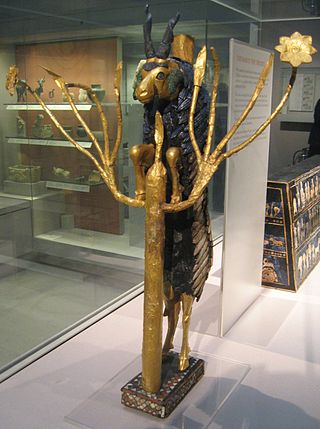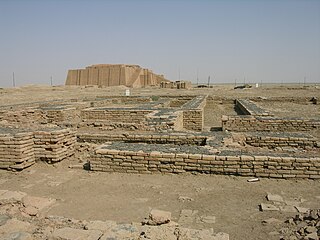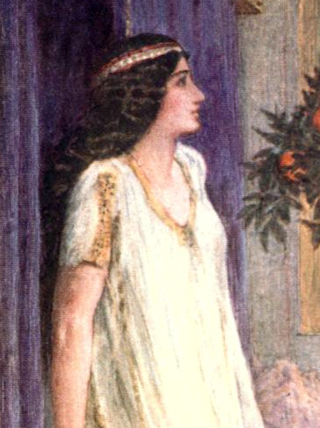Ur was an important Sumerian city-state in ancient Mesopotamia, located at the site of modern Tell el-Muqayyar in south Iraq's Dhi Qar Governorate. Although Ur was once a coastal city near the mouth of the Euphrates on the Persian Gulf, the coastline has shifted and the city is now well inland, on the south bank of the Euphrates, 16 km (10 mi) from Nasiriyah in modern-day Iraq. The city dates from the Ubaid period circa 3800 BC, and is recorded in written history as a city-state from the 26th century BC, its first recorded king being Mesannepada.

A museum is a community service that displays and preserves objects of significance. Many museums have exhibitions of these objects in public display, and some have private collections that are used by researchers and specialists. Compared to a library, a museum hosts a much wider ranges of objects and usually focus around a specific theme such as the arts, science, natural history, local history, and other topics. Public museums that host exhibitions and interactive demonstrations are often considered to be tourist attractions, and many museums attract large numbers of visitors from outside their host country, with the most visited museums in the world regularly attracting millions of visitors annually.

Puabi, also called Shubad or Shudi-Ad due to a misinterpretation by Sir Charles Leonard Woolley, was an important woman in the Sumerian city of Ur, during the First Dynasty of Ur. Commonly labeled as a "queen", her status is somewhat in dispute, although several cylinder seals in her tomb, labeled grave PG 800 at the Royal Cemetery at Ur, identify her by the title "nin" or "eresh", a Sumerian word denoting a queen or a priestess. Puabi's seal does not place her in relation to any king or husband, possibly indicating that she ruled in her own right. It has been suggested that she was the second wife of king Meskalamdug. The fact that Puabi, herself a Semitic Akkadian, was an important figure among Sumerians, indicates a high degree of cultural exchange and influence among the ancient Sumerians and their Semitic neighbors. Although little is known about Puabi's life, the discovery of Puabi's tomb and its death pit reveals important information as well as raises questions about Mesopotamian society and culture.

The Royal Game of Ur is a two-player strategy race board game of the tables family that was first played in ancient Mesopotamia during the early third millennium BC. The game was popular across the Middle East among people of all social strata and boards for playing it have been found at locations as far away from Mesopotamia as Crete and Sri Lanka. One board, held by the British Museum, is dated to c. 2600 – c. 2400 BC, making it one of the oldest game boards in the world.

The Ziwiye hoard is a treasure hoard containing gold, silver, and ivory objects, also including a few gold pieces with the shape of human face, that was uncovered on in Ziwiyeh plat near Saqqez city in Kurdistan Province, Iran, in 1947.

Meskalamdug was an early Sumerian ruler of the First Dynasty of Ur in the 26th century BCE. He does not appear in the Sumerian King List, but is known from a royal cylinder seal found in the Royal Cemetery at Ur, a royal bead inscription found in Mari, both mentioning him as King, and possibly his tomb, grave PG 755 at the Royal Cemetery at Ur.

Sir Charles Leonard Woolley was a British archaeologist best known for his excavations at Ur in Mesopotamia. He is recognized as one of the first "modern" archaeologists who excavated in a methodical way, keeping careful records, and using them to reconstruct ancient life and history. Woolley was knighted in 1935 for his contributions to the discipline of archaeology. He married the British archaeologist Katharine Woolley.

The Department of the Middle East, numbering some 330,000 works, forms a significant part of the collections of the British Museum, and the world's largest collection of Mesopotamian antiquities outside Iraq. The collections represent the civilisations of the ancient Near East and its adjacent areas.

Delphi Archaeological museum is one of the principal museums of Greece and one of the most visited. It is operated by the Greek Ministry of Culture. Founded in 1903, it has been rearranged several times and houses the discoveries made at the Panhellenic sanctuary of Delphi, which date from the Late Helladic (Mycenean) period to the early Byzantine era.

The Ram in a Thicket is a pair of figures excavated at Ur, in southern Iraq, which date from about 2600–2400 BC. One is in the Mesopotamia Gallery in Room 56 of the British Museum in London; the other is in the University of Pennsylvania Museum in Philadelphia, USA.

The Copper Bull is a copper sculpture found at the site of Tell al-'Ubaid near the ancient city of Ur, now in southern Iraq, by Sir Leonard Woolley in 1923. The sculpture, which dates from about 2600 BC, is now in the British Museum.

Ennigaldi-Nanna's museum is the earliest known public museum. It dates to circa 530 BCE. The curator was Ennigaldi, the daughter of Nabonidus, the last king of the Neo-Babylonian Empire. It was in the state of Ur, in the modern-day Dhi Qar Governorate of Iraq, roughly 150 metres (490 ft) southeast of the famous Ziggurat of Ur.

Ennigaldi-Nanna, also known as Bel-Shalti-Nanna and commonly called just Ennigaldi, was a princess of the Neo-Babylonian Empire and high priestess (entu) of Ur. As the first entu in six centuries, serving as the "human wife" of the moon-god Sin, Ennigaldi held large religious and political power. She is most famous today for founding a museum in Ur c. 530 BC. Ennigaldi's museum showcased cataloged and labelled artifacts from the preceding 1,500 years of Mesopotamian history and is often considered to have been the first museum in world history.

The Royal Cemetery at Ur is an archaeological site in modern-day Dhi Qar Governorate in southern Iraq. The initial excavations at Ur took place between 1922 and 1934 under the direction of Leonard Woolley in association with the British Museum and the University of Pennsylvania Museum of Archaeology and Anthropology in Philadelphia, Pennsylvania, United States.

The complaint tablet to Ea-nāṣir is a clay tablet that was sent to ancient Ur, written c. 1750 BCE. It is a complaint to a merchant named Ea-nāṣir from a customer named Nanni. Written in Akkadian cuneiform, it is considered to be the oldest known written complaint. It is currently kept in the British Museum. In 2015, the tablet's content and Ea-nāṣir in particular gained popularity as an internet meme.

Katharine Elizabeth, Lady Woolley was a British military nurse and archaeologist who worked principally at the Mesopotamian site of Ur. She was married to archaeologist Leonard Woolley.

Akalamdug was an early ruler of the First Dynasty of Ur in the 26th century BCE. He does not appear in the Sumerian King List, but is known from his tomb and an inscription at the Royal Cemetery at Ur. He may have been the father of Meskalamdug, as suggested by the similarity of their names and the chronological proximity of their graves. Alternatively, he may have been the son of Meskalamdug, and therefore brother of the great ruler Mesannepada.

Ur-Pabilsag was an early ruler of the First Dynasty of Ur in the 26th century BCE. He does not appear in the Sumerian King List, but is known from an inscription fragment found in Ur, bearing the title "Ur-Pabilsag, king of Ur". It has been suggested that his tomb is at the Royal Cemetery at Ur. He may have died around 2550 BCE.

A-Imdugud, was an early ruler of the First Dynasty of Ur in the 27th century BCE. He does not appear in the Sumerian King List, but is known from an inscribed seal found in tomb PG 1236 in the Royal Cemetery at Ur, which is the largest and probably the earliest tomb structure at the cemetery.
Terence Croft Mitchell was a British archaeologist, scholar and curator. He was Keeper of Western Asiatic Antiquities at the British Museum from 1985 to 1989. He specialised in West Semitic languages, Near Eastern archaeology, and also took an interest in Biblical matters from an evangelical Christian position.



















